Scottish Marine and Freshwater Science Volume 3 Number 3: Clyde Ecosystem Review
A review of previously published information and knowledge concerning the Firth of Clyde ecosystem and suggestions for further studies in the Clyde required in order to support sustainable use of this active Scottish marine ecosystem
7. THE CURRENT STATUS OF THE CLYDE DEMERSAL FISH COMMUNITY
The study by Heath and Speirs (2011 - for the remainder of this section this paper will be referred to as HS2011) provides the most comprehensive analysis of the state of the Clyde demersal fish community currently available. This section presents the results of HS2011 in some detail as the results of this study are centrally relevant to addressing some of the concerns raised by Thurston and Roberts (2010).
7.1 Summary of Demersal Clyde Landings
Figure 7.1 summarises the landings of demersal fish from the Clyde, described in detail in the previous section.
Figure 7.1 Summary of landings (tonnes) of six demersal fish species from the Clyde Sea (ICES Stat Rectangles 39E4 + 39E5 + 40E4 + 40E5. Source, MSS). Years when the Clyde opened to trawling, excluding the area within 3 nm from the coast (1962), and including within 3 nm (1984) are highlighted. Landings of Nephrops are also shown (black line).
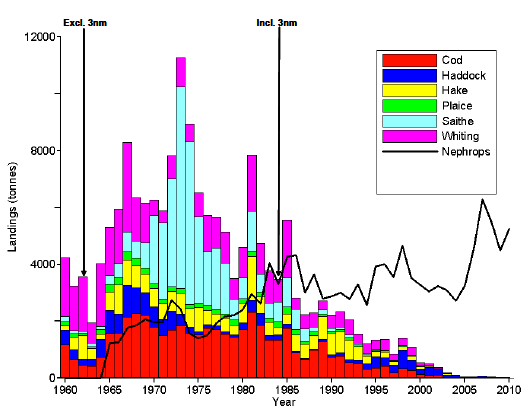
The decline in landings of demersal fish is clear. HS2011 describe the following milestones in the development of the fishing impact on the demersal fish stocks in the Clyde,
| 1889 | Entire Firth | Closed to trawlers (>8 tonnes) |
To protect inshore fishing grounds and herring |
|---|---|---|---|
| 1962 | Firth outside 3 nm limit | Opened to trawlers | Fish landings rise to 1973, then start to decline |
| 1984 | Firth inside 3 nm limit | Opened to trawlers | To keep up fish landings. To exploit inshore Nephrops grounds |
| 2001 | Parts of Clyde (see Figure 6.5) |
Seasonal closures | To protect spawning cod |
| 2000's | Fishing targeting demersal fish stops as uneconomic. Fish landings only from Nephrops fishery by-catch |
It is clear from Figure 7.1 that, following the opening of the Clyde to trawlers in 1962, landings rose towards a maximum in the early 1970s, and then have subsequently crashed. The removal of the 3nm limit in 1984 resulted in the landings rising slightly for one year, before the steep decline continued. Nephrops landings, in contrast, have steadily risen since the mid-1960s.
From landings data alone it would seem that demersal fish have disappeared from the Clyde, to be replaced by Nephrops. However, this is far from the actual true picture of the health of the Clyde Sea ecosystem.
Before moving onto how HS2011 have developed a much more accurate picture of the current status of demersal fish in the Clyde, it is worth one final consideration of the overall picture obtained from the landings data.
It might be argued that Figure 7.1 reflects the results of climate change rather than fishing. Figure 7.2 shows the average annual temperature derived from weekly measurements performed at Millport, Cumbrae, in the Clyde, compared to the data presented in Figure 7.1.
A simplistic argument might state that in the 1960s and 1970s waters were cooler than now, and landings of demersal fish were high. Now that waters have warmed, demersal fish abundances have declined resulting in lower catches. We will see from the analysis of HS2011 that this is not the case. However, even a comparison of temperature and landings as presented in Figure 7.2 can show that, when the detail is examined rather than the overall trends, there is much disparity from the simple idea that warm waters mean less demersal fish, as warm periods ( e.g. 1974-1977) can have good landings, and cool years ( e.g. 1993-1995) poor landings.
It is quite clear that overfishing has led to the decline in fish landings in the Clyde. However, landings data alone can not give the true picture of the health of the demersal fish communities in the Clyde, as we will see in the following sections.
Figure 7.2 Summary of landings (tonnes) of six demersal fish species from the Clyde Sea ( ICES Stat Rectangles 39E4 + 39E5 + 40E4 + 40E5. Source, MSS) compared to annual average temperature at Millport, Cumbrae (thick black line. Linear regression - thin black line).
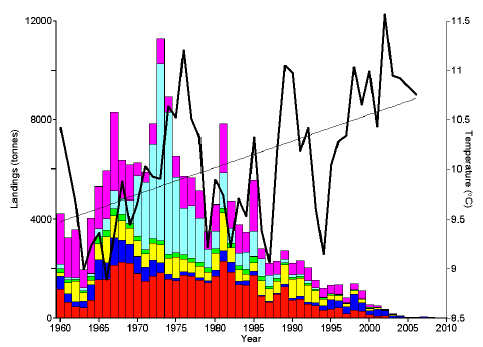
7.3 Limitations of Landings Data
HS2011 noted that the use of landings data alone is fraught with difficulty. Landings of a particular species can be affected by a diverse multitude of factors, including,
- the amount of the catch of a species that is not landed (discards)
- market demand for that species
- existing legislative controls including quotas and effort restrictions
- restricted access to the fishery for the species owing to weather
- fishing fleet decisions based on fuel price
- fishing fleet decisions based on skipper preferences and current trends
- decommissioning schemes reducing effort targeting that species
- by-catch of the species in other fisheries
For this reason, analyses as presented above and the analysis of Thurston and Roberts (2010) and it's conclusions require significant caveats applied. The difficulties associated with using landings data resulted in HS2011 focussing on research vessel survey data.
7.4 Research Vessel Survey Data
Since early in the 20 th century, the Scottish Government, through its Marine Laboratory in Aberdeen, have conducted trawl surveys of the Clyde fairly consistently on an annual basis. However, it is only since 1985 that standardised survey methods have been used.
7.4.1 Constructing the Time-Series
HS2011 took a statistical approach in order to reconstruct time-series describing the demersal fish community back until 1927. Their "gold standard" data set was the standardised survey data coordinated by the International Council for the Exploration of the Sea ( ICES) and conducted by MSS after 1985. These surveys used a net design called the Grande Overture Verticale ( GOV) net. This design, based on commercial gear at that time, is considered to be efficient at catching a wide range of fish sizes and species. Although it is not as efficient as modern demersal gear at catching specific species or sizes, it is not meant to be. It's aim is to collect a representative sample of all the fish present in an area using a standard method that does not alter one year to the next. Thus, time-series established using the GOV are comparable year on year, and the data can be used as a time-series. Stations sampled using the GOV gear after 1985 are shown as red symbols in Figure 7.3.
Although the standard surveys using the GOV net commenced in 1985, MSS and it's predecessors have conducted demersal trawl surveys since the early part of the 20 th century. In order to extend the time-series back earlier than 1985, HS2011 used other survey data collected by MSS in the Clyde Sea, selecting trawl stations that lay within close proximity to the post-1985 GOV stations ( i.e. trawls that lay within the red squares shown in Figure 7.3) and which used similar fishing gear. HS2011 performed a range of tests to ensure that the data was comparable and of sufficient quality.
For each haul performed during the surveys HS2011 used, all fish species were identified and recorded. In addition to the species name, the length of each fish of that species was measured, or a sub-set of fish measured and statistically raised to the number of that species caught. Hence, the basic data HS2011 used was the numbers of each species caught within 1cm length categories.
Other estimates HS2011 used in order to derive their statistics were the area each net used in the surveys swept (since 1985 this has been directly measured using acoustic instruments prior to 1985 estimates were made - see HS2011 for details) and a conversion between fish length and fish weight (from standard measurement for each species).
In the end, HS2011 used data from 138 hauls collected during the 83 year period between 1927 and 2009. These hauls produced nearly 20,000 sets of species length-class records. In all, 70 different species (taxa) were identified in survey trawls in the Clyde over the recorded period, 59 of which were demersal fish species (see Annex for full species list). This compares to values of 93 and 79 demersal fish species in the Sea of the Hebrides and the Irish Sea respectively. This of course does not reflect the total number of demersal fish species in the Clyde, just those that are found offshore and can be caught by the survey gear. However, it does include all species that will be affected by commercial fishing.
Statistics
In the following sections, a selection of the results presented by HS2011 has been used in order to illustrate some key findings. The reader is encouraged to study the full results in order to obtain the complete picture as presented by the authors, who also deal with the uncertainties involved in their study. They use complex indicators of species abundance, richness, evenness and size. Values of these indicators of the health and status of the demersal fish community vary from survey to survey. In order to look at inter-annual trends, HS2011 fit statistical models to the data, especially a loess smoother model. For simplicity, in the sections below this is referred to as "average" results.
Figure 7.3 Map showing the location of trawl sampling locations used in the analysis of HS2011. Also shown are ICES statistical rectangles (dashed lines) they used to obtain landings and discard data. Red symbols indicate the locations of research survey vessel trawl tows performed by Marine Scotland Science using a standard survey gear (the GOV net) after 1985. The three red rectangular cells show the sub-areas used to select other trawl stations (blue symbols) where data was obtained using non-standard fishing gear.
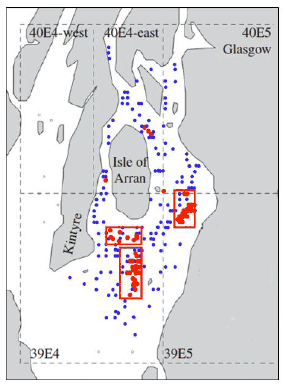
7.4.3 Demersal Fish - Changes in Biomass
Figure 7.4 shows the average abundance (biomass) of the commercial demersal fish species (sum of cod, haddock, whiting, hake, saithe and plaice) in the Clyde Sea calculated using research vessel survey data, from HS2011. The data is presented as the weight (tonnes) of fish in the Clyde in an average year within the stated decades. The data is sub-divided between fish that are smaller than the Minimum Landing Size ( MLS) and larger than the MLS. Note that each species making up the six demersal fish has a species-specific MLS which is used in the calculation of the "greater than" and "less than" MLS percentages. Also shown in Figure 7.4 are the decadal average landings for 1960 onwards.
Figure 7.4 Average abundance (biomass) of commercial demersal fish species (sum of cod, haddock, whiting, hake, saithe and plaice) in the Clyde Sea calculated using research vessel survey data, from HS2011. The data is presented as the weight (tonnes) of fish in the Clyde in an average year within the stated decades. The data is sub-divided between fish that are smaller than the Minimum Landing Size ( MLS) and larger than the MLS. (Note: Data has been extracted from HS2011 Figure 4 for <MLS and >MLS loess smoothing functions, raised to the area of the Clyde Sea, i.e. 3700 km 2, and averaged over relevant decades). Also shown is the decadal average landings for 1960 onwards.
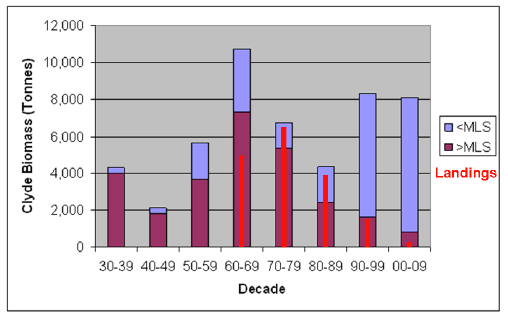
The principal aspects of Figure 7.4 to note are:
- landings in the decade 1960-1969 appear to have been 46% of the total biomass. This percentage became 99% in the decade 1970-1979, 91% in 1980-1989, 18% in 1990-1999 and 2% in 2000-2009.
- the biomass of demersal fish in the Clyde in the decades 1990-1999 and 2000-2009 was over 8000 tonnes. This is approximately twice the biomass of fish in the decade 1930-1939 (~4000 tonnes) and approximately four times the biomass in the decade 1940-1949 (~2000 tonnes).
- in the decades 1930-1939 and 1940-1949, fish smaller than the minimum landings size made up on average 11% of the total biomass, whereas in the decades 1990-1999 and 2000-2009, fish smaller than the minimum landing size made up on average 85% of the biomass.
The first observation throws up some difficulties. It is not possible that a harvest ratio of 99% can be sustained for a decade without demersal stocks being completely eradicated from the Clyde. This suggests that there is a scaling factor required between the estimated total biomass and the landings data. Landings data are from official estimates derived from market sampling and log book records. The biomass is from HS2011 using calculations involving the swept area of survey nets, the catch per unit time of a survey net, and the catchability of a species in the survey net, with the final estimated values of fish density raised to the area of the Clyde Sea. Thus there may well be scaling issues with the estimation of total biomass. The estimates are undoubtedly too low. However, it may be assumed that this scaling factor applies equally to all years, thus comparisons between decades of estimated biomass remains valid.
It is quite clear from the Figure 7.4 that, despite the scaling issue, there was extremely heavy exploitation of the demersal fish stocks in the decades 1960-1969, 1970-1979 and 1980-1989.
What is also clear is that, despite the intense fishing pressure on demersal stocks that took place in those decades, the biomass of demersal fish bounced back and in fact became greater than in the decades when fishing pressure was much lower, prior to the 1960s.
Although the total biomass of demersal fish recovered, the size of individual fish was much changed in recent decades compared to previous decades. While there was a recovered biomass, it was predominantly small fish, with >80% being smaller than the minimum landing size.
In terms of species, >70% of the small fish was whiting (see Section 7.4.4 below).
In terms of age, Figure 7.5 shows that the small whiting have been predominantly 1 year olds at least since the late 1990s.
These observations must imply that the Clyde is indeed productive. Primary production in the form of phytoplankton growth, and secondary production in the form of zooplankton growth each year supports a large biomass of young, 1 year old whiting.
Figure 7.5 Age of whiting caught in research vessel survey trawls in the Clyde Sea. From the Scottish Groundfish Survey Quarter 1, Marine Scotland Science. Units are a standardised index.
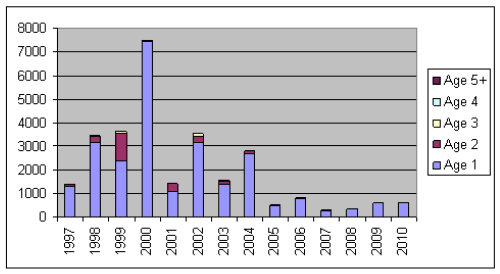
A valid question is where are the spawners? What fish are reproducing and producing each year an influx of new 1 year olds?
There are no comprehensive answers to these questions. Whiting can sexually mature at age 1, although no maturity data has yet been examined for Clyde whiting. The surveys that Figure 7.5 is drawn from may have missed the spawning older fish. They may be in the areas the survey did not cover, including the upper Firth, the sea lochs and the coastal zone. An alternative may be that the spawning population is not within the Clyde at all, and the population of small whiting in the Clyde is created by recruitment from a distant spawning population, although this is thought to be unlikely. In order to find the answer to these questions, a survey of small fish in the Clyde is needed, focussing on sexual maturity.
Another valid question is; what happens to the older fish? Again no conclusive answers are available. However, Figures 7.6 and 7.7 provide some clues.
Figure 7.6 Numbers of whiting discarded from the Clyde Nephrops fishery, by age. Numbers are discarded fish per observed fishing trip, derived from the MSS observer programme.
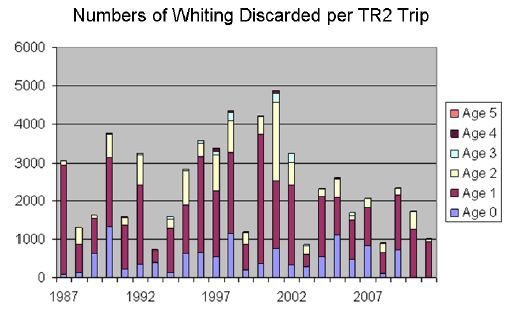
Figure 7.7 Weight of whiting discarded per tonne of Nephrops landed for every observed trip since 2005. Data is from the MSS observer programme.
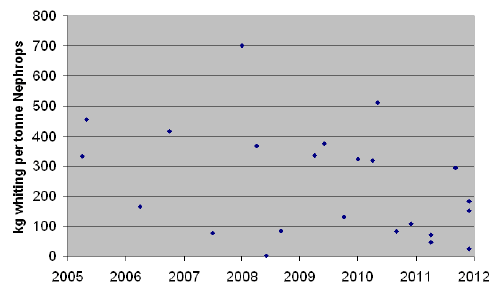
Figure 7.6 reveals that there have been significant discards of whiting from the TR2 Nephrops fishery. Up until 2009, pre-recruit (age 0) whiting were caught and discarded. The absence of age 0 whiting in the discards after 2009 may be related to the increase in cod-end mesh size from 70 mm to 80mm that occurred at the start of 2009.
Also in some years ( e.g. 2001) significant numbers of 2 year old fish were caught and discarded. There is evidence of even older fish, 3 and 4 years old being included in the discards, although numbers are small.
Figure 7.7 shows the amount of whiting discards in relation to the amount of Nephrops landed by an individual fishing trip by a Nephrops vessel. The average discard rate over the period 2005 to 2012 is 241 kg of whiting discarded for every tonne of Nephrops landed, although individual trips have much higher values.
In 2009 the landings of Nephrops from the Clyde was 4460 tonnes. Using the average value of 241 kg of whiting discarded per tonne of Nephrops landed, this implies that in 2009, 1070 tonnes of whiting were discarded from the Nephrops fishery. In 2009, the estimate of the total biomass of whiting is 5,300 tonnes. Hence the by-catch of whiting in the Nephrops fishery exerted a fishing pressure with a harvest ratio of 0.2 ( i.e. 20% of the whiting biomass is discarded in the Nephrops fishery each year). This is very similar to that calculated using other methods by HS2011.
Therefore, the suggestion from this analysis is that the Nephrops fishery in the Clyde may be partly responsible for the current absence of older, larger fish in the Clyde.
In summary, from the estimates of biomass in the Clyde Sea the conclusions are:
- the biomass of demersal fish in the Clyde is now greater than it was in the 1930's and 1940's. In fact more than twice as great.
- but 90% of this biomass is smaller than the minimum landing size, and 72% of it is whiting.
- the demersal fish biomass has recovered from the incredibly high exploitation rates in the 1970's and 1980's.
- hence the Clyde marine ecosystem is productive. It therefore has the potential to be restored.
- however, it is in a new regime with abundant small fish and few large fish.
- in order to recover the ecosystem towards a healthy state, we need to find measures which allow large fish to survive and increase.
7.4.4 The Mix of Demersal Fish Species in the Clyde
Using the survey data, HS2011 show how the mix of fish species in the Clyde has altered. To do this they use a measure called "evenness". This measure has a value of close to 1 when all species are equally present, but reduces to very low values if a few species dominate. A healthy ecosystem is generally thought to have an even mix of species, and the evenness should not alter drastically.
In the Clyde, HS2011 found that the average evenness factor declined significantly between 1980 and 2000, although has since started to recover ( Figure 7.8). This can also be seen in Figure 7.9, which presents the species mix which makes up 95% of the demersal fish biomass during five different fishing "regimes" in the Clyde:
Figure 7.8 The average (loess smoother) value of the species evenness indicator, calculated using research vessel survey data for the Clyde demersal fish community HS2011. This indicator has a value of 1 when all species are equally present, and reduces towards zero as fewer species dominate a community.
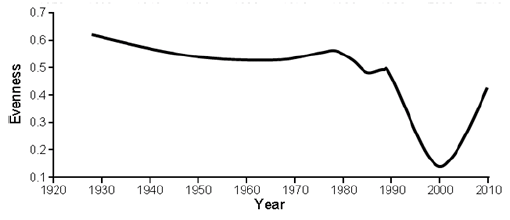
| Period | Fishery Regime |
|---|---|
| 1920 - 1959 | Clyde closed to large trawlers |
| 1960 - 1979 | Clyde opened to large trawlers beyond 3 nm (opened in 1962) |
| 1980 - 1994 | 3 nm limit removed (1984) - PEAK EXPLOITATION AND COLLAPSE |
| 1995 - 2004 | Nephrops fishery commences - demersal vessels convert |
| 2005 - 2009 | Nephrops fishery continues (by-catch of demersal fish) |
Figure 7.9 The species in the Clyde that make up 95% of the biomass of Clyde demersal fish (from Table 1, HS2011).
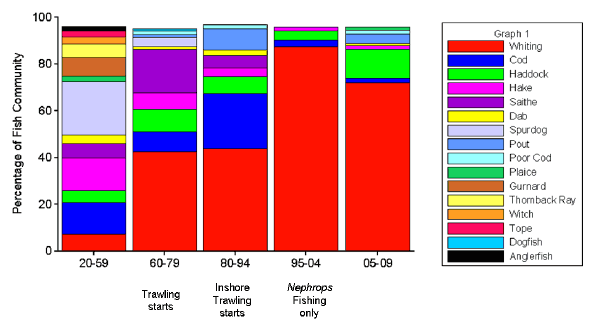
From Figure 7.8 the species change that resulted in the decline of the evenness indicator is evident. Whiting increased from just 7% of the species mix in 1920-1959, to a maximum of 87% in 1995-2004. In the earlier period there were 13 species making up 95% of the biomass, whereas by 2004 there were just 4 species in the mix. The large predator fish spurdog, which made up 23% of the demersal fish biomass in the earlier period, vanished from the top species list by 1980. In contrast, small fish such as poor cod and Norway pout, which were present in the earlier period but did not make it into the top species list, increased in significance and after 2005 represented about 4% and 2% respectively of the demersal fish biomass. Figure 7.10 presents this changing species mix pictorially.
Figure 7.10 Pictorial representation of the change in the species mix making up 95% of the demersal fish biomass between 1920-1959 and 2005-2009 in the Clyde Sea (from Table 1, HS2011). Pictures and photos from FishBase.
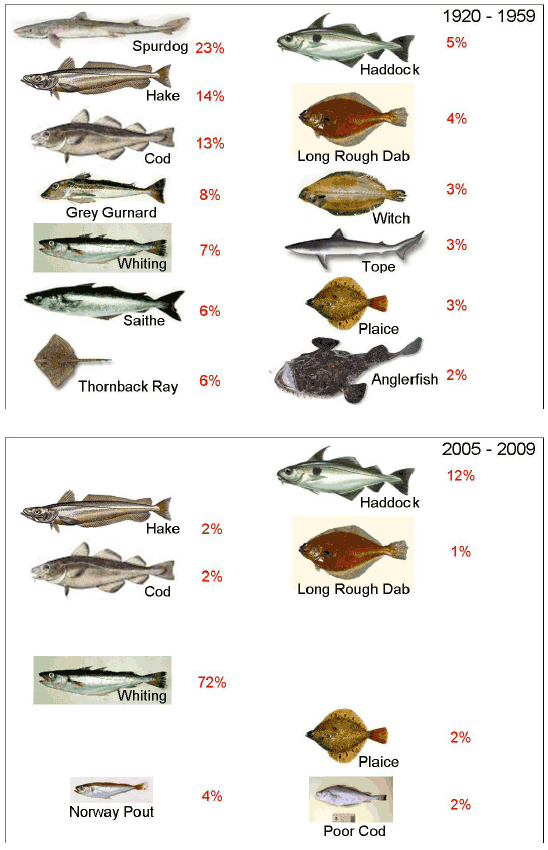
Conclusions from the study of the mix of species in the Clyde can be summarised as follows:
- Fishing has significantly altered the mix of species in the Clyde.
- The fish community has changed from an even one, with many large predator species, to one dominated by whiting and other small fish.
- Along with other indicators and tagging data, the fact that species evenness changes in the Clyde very differently than that observed in nearby waters in the Sea of the Hebrides and the Irish Sea, confirms that the Clyde fish populations respond locally to fishing pressure.
-This also suggests that the Clyde can be managed separately from the Scottish west coast, with a good chance of recovery using local restoration measures irrespective of what happens elsewhere.
- Indeed, conservation measures applied to the west coast as a whole may not be sufficient for the Clyde, as it responds differently and independently from the adjacent coastal waters.
- HS2011 found that there was a lag of about 20 years between the maximum average relative removal of fish from the Clyde (the Harvest Ratio peaked in about 1980) and the maximum effect on the mix of species (which reached a minimum in 2000). Such a lag is found in other indicators HS2011 use of the health of the demersal fish community in the Clyde. It is typical of the complex interactions which exist in an ecosystem, and shows that we can not expect restoration measures to have immediate effects. This is particularly true if we have forced the Clyde ecosystem from one stable state to another.
There are already positive signs of change in the Clyde Sea demersal fish populations.
Since 2000 the species evenness index is increasing. In the period 1995-2004 just 4 fish species made up 95% of the biomass of Clyde demersal fish, whereas in 2005-2009 this had increased to 8. In the earlier period 87% of the biomass was whiting, while in the later period this had decreased to 72%. Possibly the most positive sign is in the size of the biomass itself, which has shown a significant increase since 1990. All of these indicators of improving conditions in the Clyde should be strong arguments supporting the prospect of a restored Clyde.
The changes in technical measures in the Clyde Nephrops fishery (change from 70mm to 80mm mesh size, introduction of square mesh panels) potentially assist in reducing catches of small fish and may have contributed to some of the early signs of improvement recorded in this study. For this improvement to continue, further developments are required in order to allow higher proportions of medium and large size fish to escape and grow.
If we are to design optimum restoration plans for the Clyde Sea, they must be built on sound science. However, we can not wait indefinitely for the results of further scientific studies. An integrated science / policy approach is needed so that progress can be made on both fronts at the same time. To be successful, this should intimately involve all sectors of society with an interest in the future of the Clyde Sea.
It could be argued that the Clyde gives Scotland an opportunity to demonstrate leadership in terms of ecosystem restoration. It is our own inland sea, over which we have significant management control. We will be required to bring the Clyde to Good Environmental Status by 2020 by the Marine Strategy Framework Directive. Currently the Clyde would certainly fail tests such as the Large Fish Indicator, and measures of biodiversity health. A restored Clyde ecosystem could bring market advantages to the fishing industry, through ecolabelling and headline conservation achievements. However, fishing sectors will have to work together in an open and transparent way. The allocation of blame is an entirely wasteful activity. Conservationists must also accept that the Clyde is not a pristine ecosystem and never will be. It is heavily used by society for many legitimate purposes, of which food extraction is one. Focus must always be on the best way forward for all. Compromises will be possible if all stakeholders approach the challenges in a constructive way.
7.6 Suggestions for Further Work
A comprehensive survey of demersal fish in the Clyde is required, including small fish. The survey should include a focus on the sexuall maturity and stock identification of whiting. The survey could be accompanied by increased observations of the discards of demersal fish in the Nephrops fishery.
Contact
There is a problem
Thanks for your feedback